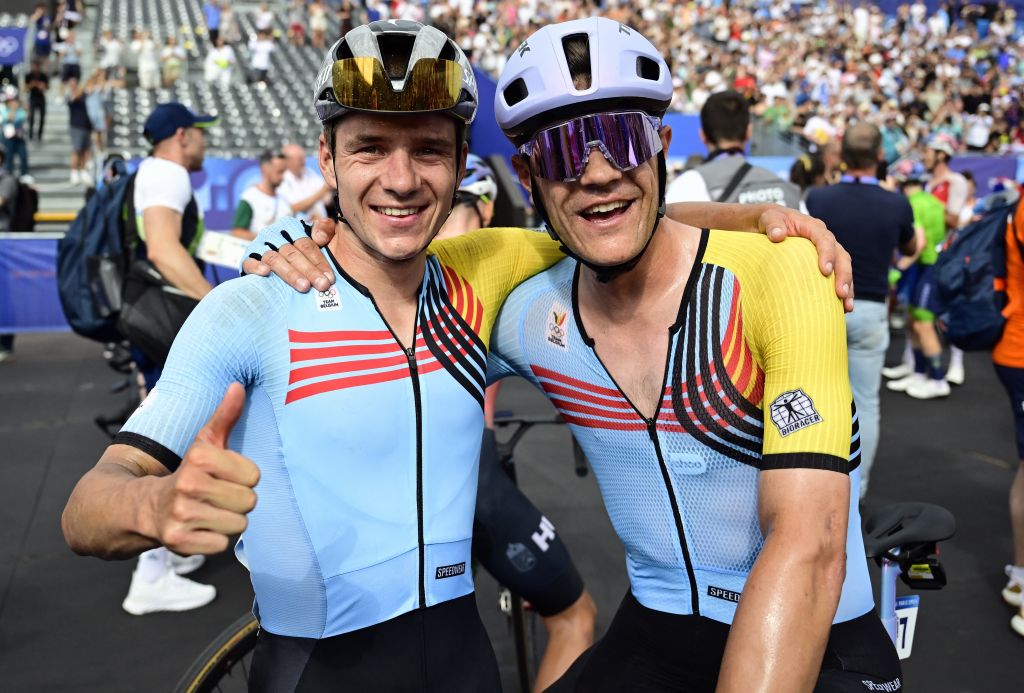
Amidst celebrating Remco Evenepoel’s second Olympic Games gold medal in a week, his Belgian teammates recounted their young leader’s devastating series of attacks and how it left their rivals dazed, confused and defeated.
Belgian riders Jasper Stuyven, Wout van Aert and Tiesj Benoot provided the groundwork for Evenepoel to succeed and were also able to witness the effects of Evenepoel’s killer blows to the opposition at the critical moments, right down to his final move when shedding closest pursuer Valentin Madouas (France) with 15 kilometres to go.
“He had already said yesterday [Friday] that he thought that was a good place to attack, and when he accelerated there, it was impressive,” Stuyven told Sporza.
Evenepoel could have waited for the third and final ascent of the Butte de Montmartre to shed his last rival to withstand his attacks. But Stuyven explained that whereas a move at Montmartre would have been overly predictable, and therefore perhaps more possible to resist, “the place where Remco chose to attack was the second-longest climb on the finishing circuit, during a very tough part of the course”.
“He was really looking forward to going there, because he knew that everyone would be at their wits’ end. And that turned out to be the case,” Stuyven added.
The Belgian team were unique in that they had two winners to play off – Evenepoel with a long-ranged attack and Van Aert for a small bunch sprint.
While Van Aert crashed in the closing kilometres and wasn’t able to contest for the medals, the Belgian team’s strategy was dependent upon Stuyven and Benoot selflessly chasing down every dangerous attack and, because there were no race radios, using their energy to go back to the team cars to get information.
The latest race content, interviews, features, reviews and expert buying guides, direct to your inbox!
Benoot’s most important moment arguably came when he single-handedly led the peloton in their chase of a dangerous move led by Ben Healy (Ireland) and
containing Valentin Madouas (France), Marco Haller (Austria), Mike Woods (Canada), Fred Wright (GB) and Stefan Küng (Switzerland).
“I went to the car just before the circuit to ask what the situation was, then I was like, ‘OK, Healy and Lutsenko alone 25 seconds’. Then I came back in front and a group of of 6, 7, 8 guys was gone,” Benoot told Cyclingnews.
“Jasper thought first that Remco was also there so we didn’t pull but then we saw Remco just behind us, I said ‘fuck’. Then we knew I had to start pulling immediately. Because there was no speed in the bunch and if you would give those guys three minutes on the local laps, it would be really difficult to catch them back. So like this, we could save the day.”
The lack of race radios combined with the maximum four-rider teams made it even more remarkable that Belgium could pull off their strategy.
“When you have two leaders with Wout and Remco you also need to take responsibility,” Benoot said. “It was a bit tricky with a strong group going just before the local laps, but I could manage to keep them close. And then Wout needed to be there when Mathieu van der Pel would go and actually did I think. Then Remco took his moment, actually where he said he would go, he did it.”
Evenepoel’s success has provided Belgium a major landmark in cycling history, as he is the first-ever male rider to secure gold in both road and time trial events in a single Olympic Games. Evenepoel is also the first Belgian to secure two golds in a single Olympics since archer Edmond Cloetens in 1920.
“This is something they’re going to show in some documentary in 20, 30 or 40 years,” national coach Sven Vanthourenhout added before describing the final incident where Evenepoel punctured, with 3.8km to the finish under the Eiffel Tower.
“It was super hectic to be there with the car, we drove a race within a race for it,” he said.
“I wanted to calm him down immediately afterwards by riding next to him and communicating his lead. The commissaires actually didn’t allow that, so it might cost me a fine,” he added with a grin.
As for the Evenepoel’s gold medal, “We all have to enjoy this, as a team and as a federation,” he concluded.
“This is a unique moment. We are here with a world-class team, both on and off the bike. I am so proud of the entire team.”
Get unlimited access to all of our coverage of the 2024 Olympic Games – including breaking news and analysis reported by our journalists on the ground from every event across road, mountain bike, track and BMX racing as it happens and more. Find out more.

